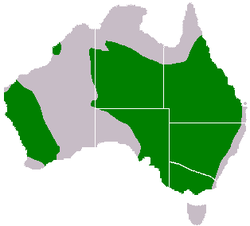| Black-tailed nativehen | |
|---|---|
 | |
| Scientific classification | |
| Kingdom: | Animalia |
| Phylum: | Chordata |
| Class: | Aves |
| Order: | Gruiformes |
| Family: | Rallidae |
| Genus: | Tribonyx |
| Species: | T. ventralis |
| Binomial name | |
| Tribonyx ventralis (Gould, 1837) | |
 | |
| Range in green | |
| Synonyms | |
Gallinula ventralis | |
The black-tailed nativehen (Tribonyx ventralis) is a rail native to Australia.
